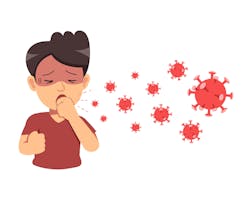The Centers for Disease Control and Prevention (CDC) has revised its guidance on how COVID-19 spreads to include airborne transmission.
The CDC maintains that COVID-19 most commonly spreads through close contact (within 6 feet) and prolonged exposure with an infected person through respiratory droplets. People produce respiratory droplets when they sneeze, cough, talk, sing or breathe. These respiratory droplets are then inhaled or absorbed when they inhale or touch their hands to their eyes, nose or mouth.
The CDC now acknowledges that COVID-19 also spreads through airborne transmission of particles that can “linger in the air for minutes to hours” and among people who are more than 6 feet apart.
“There is evidence that under certain conditions, people with COVID-19 seem to have infected others who were more than 6 feet away,” according to the website. “These transmissions occurred within enclosed spaces that had inadequate ventilation. Sometimes the infected person was breathing heavily, for example while singing or exercising.”
The updated guidance reflects findings of published reports that found “limited, uncommon circumstances” where people with COVID-19 infected others at greater distances or after they had left the area.
“In these instances, transmission occurred in poorly ventilated and enclosed spaces that often involved activities that caused heavier breathing, like singing or exercise,” the CDC said in a statement. “Such environments and activities may contribute to the buildup of virus-carrying particles.”
The CDC continues to recommend maintaining social distance, wearing a mask that covers the nose and mouth, frequent and thorough hand washing, disinfecting commonly touched surfaces often and self-isolate if sick.
Last month, the CDC posted a “draft version of proposed changes” that said the virus could spread through aerosols, reported CNBC. The CDC also recommended people use air purifiers to reduce airborne germs indoors to stop the disease from spreading, warning that poorly ventilated places increase the risk of spreading. That updated guidance was said to be in error and quickly removed.
It’s another example of how recommendations and best practices have evolved and confusion can arise as infectious disease experts and the medical community learn more about the novel coronavirus. That can pose serious implications for organizations on how to resume operations and how to keep their employees safe.
Air filtration and ventilation systems could be an important piece of the puzzle as social distancing, being outdoors and limiting interactions isn’t always possible at work sites.
“Have your air handling system reviewed and see how efficient it is and whether you’re getting sufficient air exchanges per hour, and where the stuffy corners of the building are,” Bill Schaffner, MD, professor of preventive medicine and infectious diseases at Vanderbilt University, told CNBC. “See if you can do something to enhance the air handling.”
About the Author
Nicole Stempak
Nicole Stempak is managing editor of EHS Today and conference content manager of the Safety Leadership Conference.

